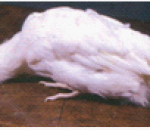The infectious bursal disease is an acute highly contagious, infectious viral disease of the growing chickens characterized by sudden onset, short course and extensive damage in the bursa of fabricius followed by death or rapid recovery. It was first recognized in Gumboro District of Delaware (USA) hence also named as “Gumboro Disease”. It is caused by a small birnavirus (called IBD virus) that belongs to he birnaviridae family.
There are two serotypes of infectious bursal disease. Serotype 1 is classic form and its variant are commonly encountered in chicken disease. Serotype 2 is most prevalent in turkeys but it does not cause any reported disease. These two serotypes share a group antigen but there is no cross-protection between the serotypes.

Transmission
- Chicken infected with IBD virus shed the pathogens in their feaces. Contaminated litter, feed and water are a source of transmission of virus. Other chickens in the house become infected by ingesting the virus.
- Direct contact with infected birds and mechanical carriers (attendants, visitors, rats, wild birds and insects) can be the source of transmission.
- There is no evidence regarding vertical transmission of IBD virus.
Clinical Signs
Causative virus damages the B cells in the bursa and reduces plasma cells in Gland of Harder. The variant strains are more immunosuppressive than the classic strains and induce damage in the bursa of fabricius of affected chickens even when high and uniform antibody titres are present.
1. Sudden onset (Chicks appear sick overnight)
2. Severe depression. Affected birds have a tendency to sit and when forced to move, have an unsteady gait.
3. Loss of appetite
4. Droopy appearance, ruffled feathers.
5. Birds pick at their own vent
6. A slight to severe trembling and prostration
Advance signs are following
1. Dehydration
2. Whitish, watery r mucoid diarrhea
3. Strained defecation
4. Enlarged bursa (atrophied in advanced cases)

bursa three days post infection
5. Mortality pattern shows a typical bell shape curve
6. Usual mortality is 8-10. The virus may kill up to 50% of susceptible flocks.
Postmortem Lesions
1. Dehydrated carcass
2. Muscular haemorrhage (leg, thigh and pectoral), some times at the junction of proventriculus and gizzard.
3. Haemorrhages of pectoral leg muscles are typical of IBD
4. Intestine with excess mucus
5. Bursa is inflamed, enlarged, edematous and exhibit creamy colour (in early stage). Bursa will be atrophied if postmortem examination is done on 3 – 8 days after the start of infection. Haemorrhage can also be found on internal serosal surfaces.
6. Liver- swollen, friable and yellow streaked
7. Spleen- Splenomegaly and in ssome cases grey foci dispersed on the surface.
8. Kidneys- Swelling and white appearance, dilatation of tubules with urates (cell debris, occasionally).
Differential Diagnosis
1. Muscular haemorrhages in vitamin k deficiency and sulphonamide poisoning (they do not have fever while in IBD, there is fever)
2. Proventricular haemorrhages resemble ND.
3. Liver lesions resemble mycotoxicosis.
4. Renal lesions resemble IB nephrosis (no bursa lesions in IB).
5. Urates deposits in ureters resemble visceral gout, avitaminosis A and dehydration.
Treatment
No specific treatment, only supportive therapy.
Prevention and Control
A comprehensive prevention program against IBD includes following three components:
1. Protect early damage to bursa in chicks by ensuring god levels of MDA (maternal derived antibodies) in day-old chicks through an effective breeder vaccination program.
2. Ensure strict biosecurity measures to prevent entry of field viruses on the farm. Use disinfectants in actual farm conditions and disinfect the farm building between two batches/flocks. Pay special attention to the sanitation of the drinking water.
3. Follow a proper vaccination program. Successful vaccination depends upon the selection of a proper vaccine strain and vaccination schedule.
4. Timely (at age of 4-6 weeks) monitor the bursa size of the broiler flock. Calculate bursa weight as compared to the percentage body weight. Less than 0.13% value will indicate the infected birds.


